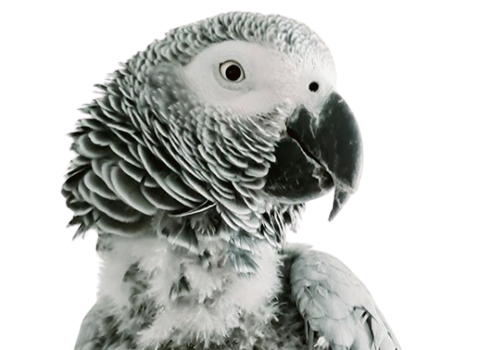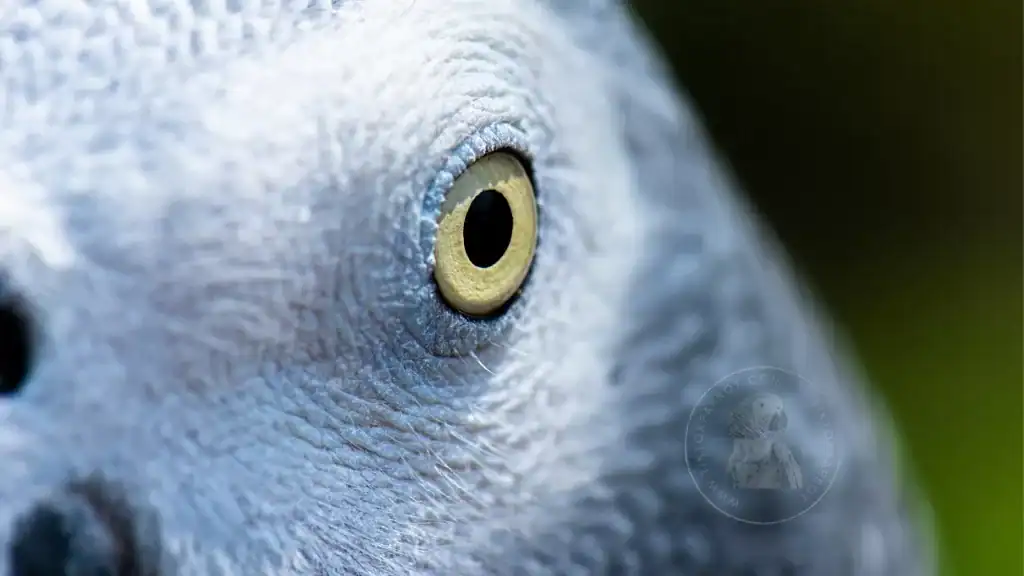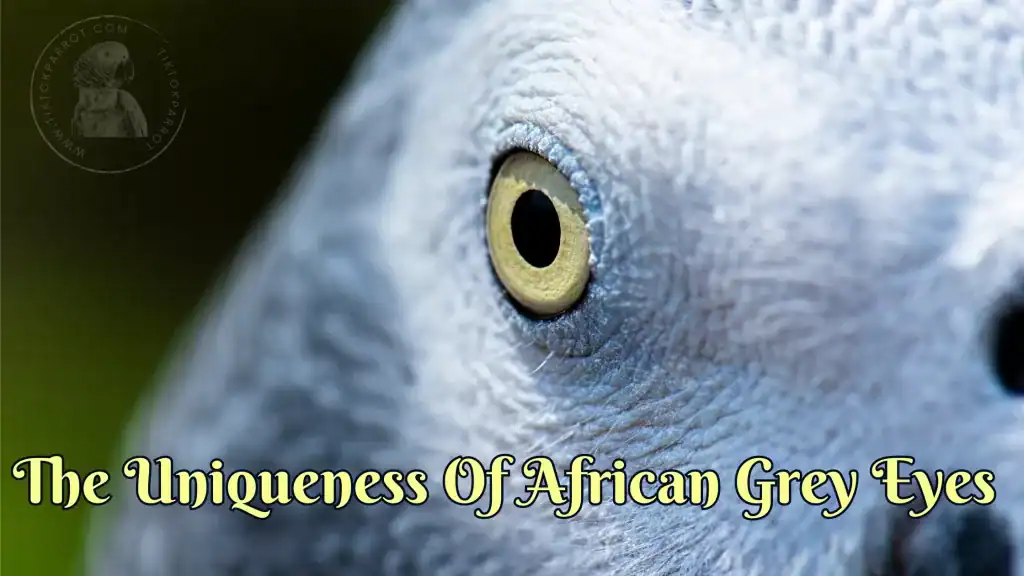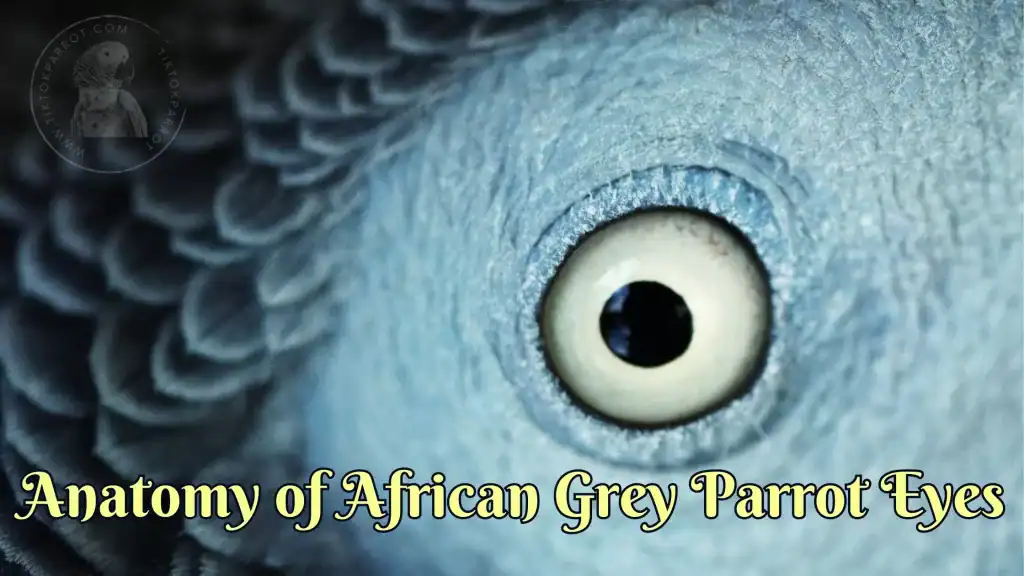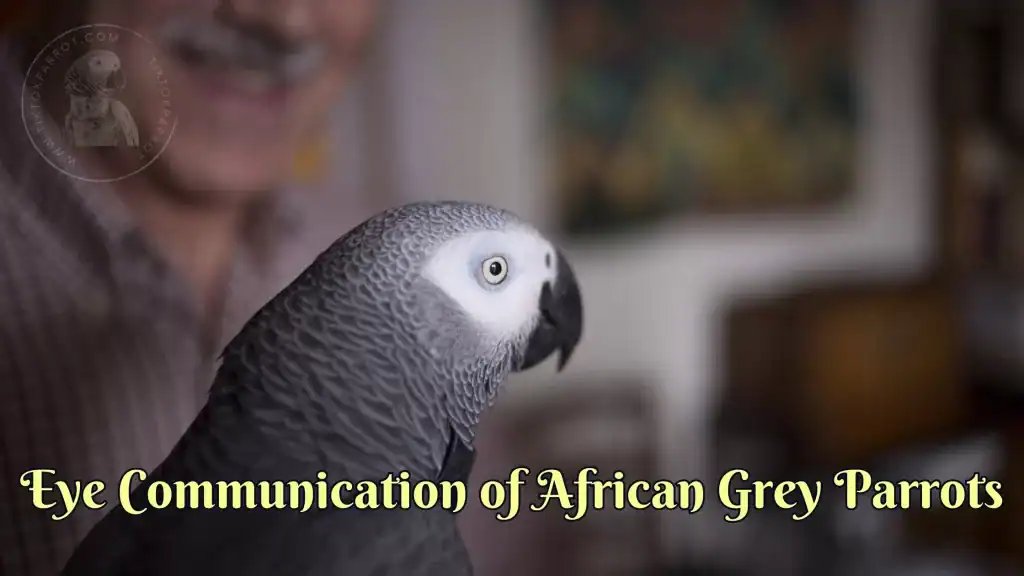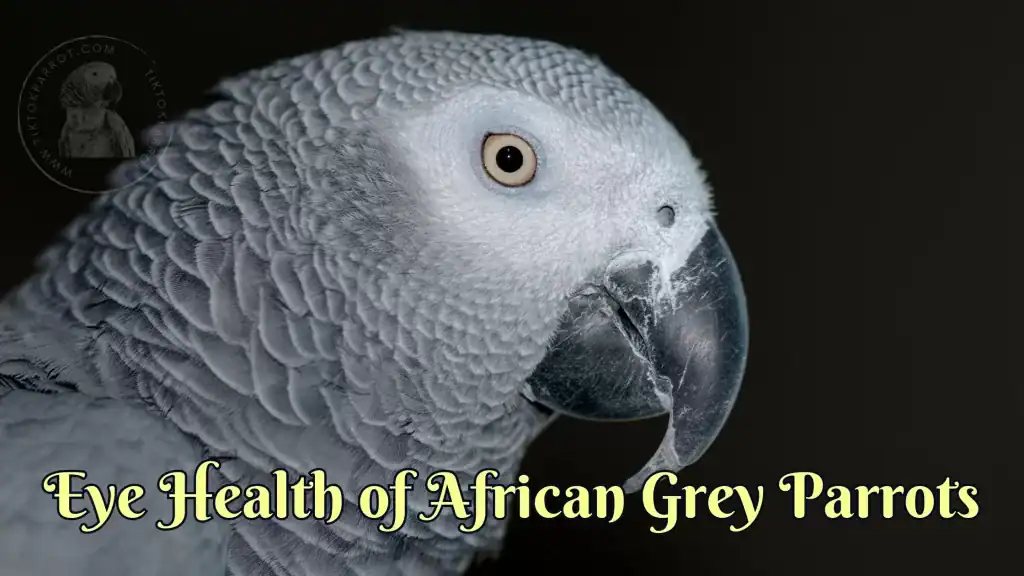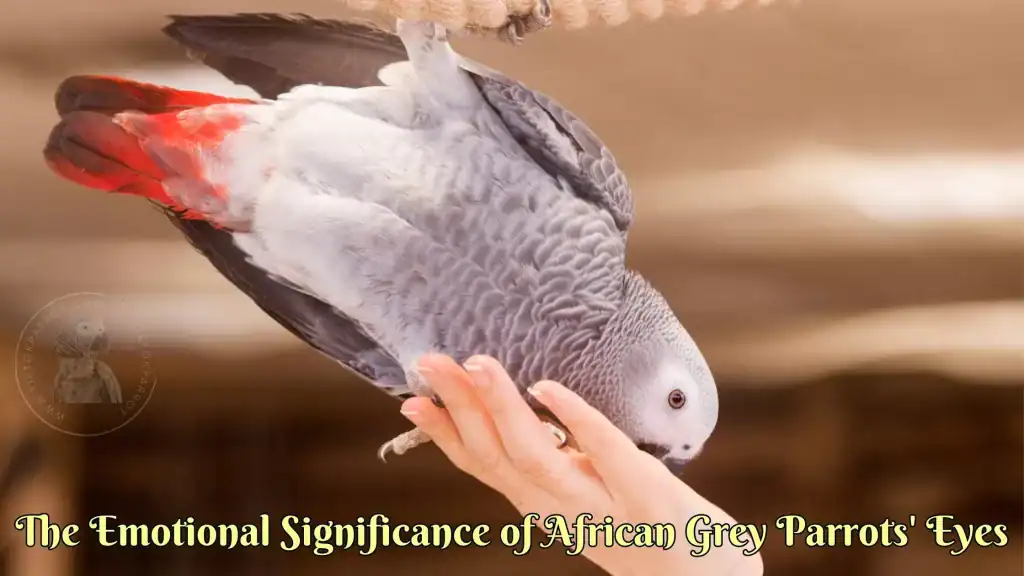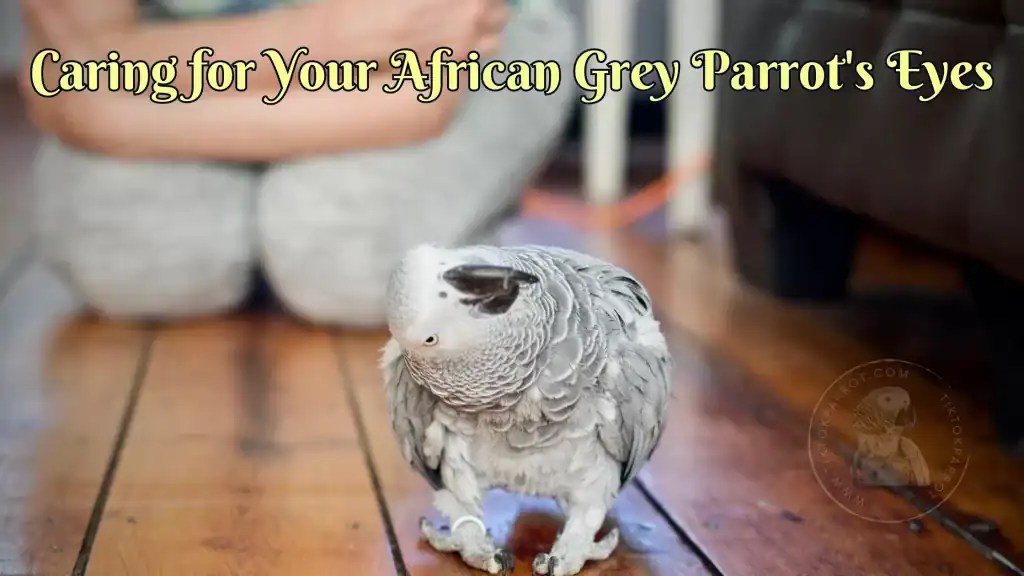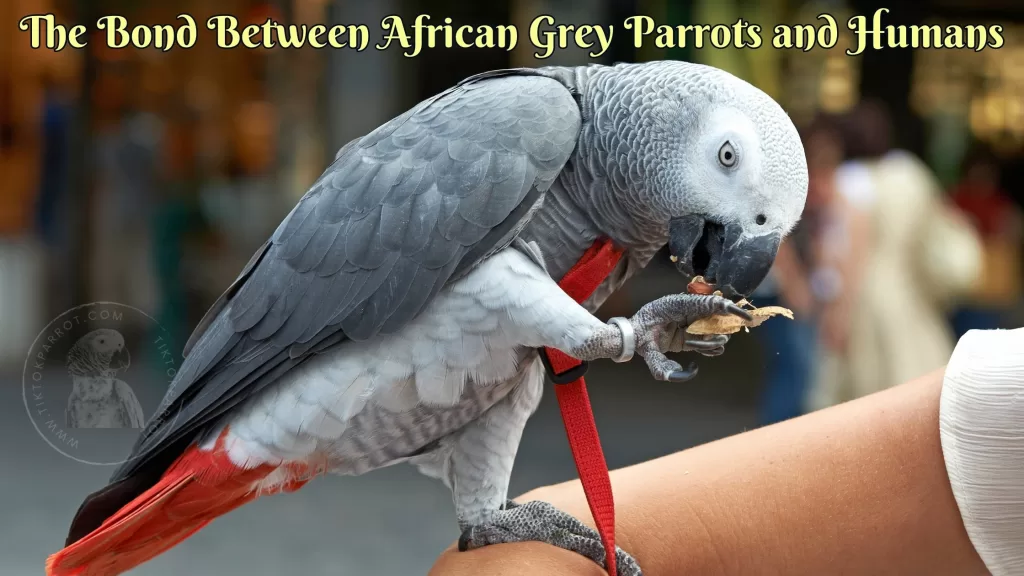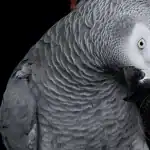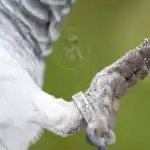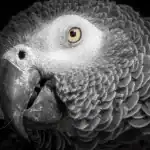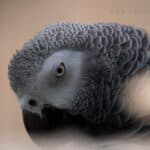African Grey Parrots are popularly known for their high intelligence and excellent mimicking abilities, but their eyes have equally captivating features. These parrots are a favorite among bird enthusiasts, and their unique eyes contribute to their beauty and charm.
The eyes of African grey parrots can reveal their emotions and even their health status. This article explores the mesmerizing eyes of grey parrots, what they can tell, and why they are essential.
Discover the mesmerizing eyes of African grey parrots and learn what they can tell you about your beloved bird’s emotional state and health. From anatomy and communication to preventive measures and treatments for common eye problems, this comprehensive guide has everything you need to know to care for your parrot’s eyes and build a strong bond based on trust and affection.
Introduction
African Grey Parrots’ physical characteristics
African grey parrots are medium-sized birds that have a distinctive appearance. They have a stocky build with a short, squared tail and a large, hooked beak. Their feathers are predominantly grey, with lighter shades on their chest and darker ones on their wings and tail.
The beak and feet are black, and they have a bare patch of white skin around their eyes. The eyes of grey parrots are dark and round, with a distinct ring of light grey surrounding the iris. The average length of an African grey is around 33 cm, and they can weigh between 400 and 600 grams.
The uniqueness of African Grey eyes
The eyes of African greys are unique in several ways. They have a round, dark pupil surrounded by a ring of light grey, which gives them a distinctive appearance. The skin around their eyes is bare and white, which makes their eyes stand out even more.
Their eyes are also very expressive and can reveal a lot about their emotions and health status. For example, the size of their pupils can indicate their level of excitement or anxiety, while changes in the color or clarity of their eyes can signal underlying health problems.
The unique appearance and expressive nature of grey parrot eyes make them a fascinating and important feature of this beloved bird species.
Importance of understanding their eyes
Understanding the eyes of African grey parrots is important for several reasons. First, their eyes are a key component of their communication system, and being able to interpret their eye movements and expressions can help owners better understand their bird’s emotions and needs.
Second, grey parrots are prone to certain eye conditions, and being able to recognize the signs and symptoms of these conditions can help owners seek prompt veterinary care and ensure the best possible outcomes for their bird’s health.
Finally, caring for their eyes properly can contribute to their overall well-being and quality of life. This includes providing a healthy diet that promotes eye health, maintaining a clean environment to prevent eye infections, and seeking regular veterinary check-ups to catch and treat any potential issues early.
Understanding the eyes of African grey parrots is essential for promoting their emotional and physical health and building a strong bond between owners and their beloved birds.
Anatomy of African Grey Parrot Eyes
The anatomy of African grey parrot eyes is unique and fascinating. Their eyes are relatively large and round, with a dark, round pupil at the center. The iris is surrounded by a ring of light grey that gives their eyes a distinctive appearance.
The skin around their eyes is bare and white, which makes their eyes stand out even more. Grey parrots’ eyes are also positioned on the sides of their head, which gives them a wide field of vision but can make it challenging for them to focus on objects directly in front of them.
In terms of eye color, greys can have dark brown, black, or grey eyes. Overall, the anatomy of African grey eyes is fascinating and plays an important role in their communication, health, and well-being.
Eye shape and size
The eye shape and size of African grey parrots are unique and play an important role in their vision and communication. The eyes are relatively large and round, with a dark, round pupil at the center. The iris, which surrounds the pupil, is relatively small, but a ring of light grey around the iris gives the eyes their distinctive appearance.
The position of the eyes on the sides of their head gives greys a wide field of vision, but they have limited depth perception and cannot focus on objects directly in front of them as well as humans can.
The shape and size of this parrot eyes are well-suited for their lifestyle and communication needs, but they have some limitations compared to human eyes.
Eye coloration and patterns
African grey parrots can have varying eye coloration and patterns. Most commonly, their eyes are dark brown, black, or grey. The iris, which surrounds the pupil, can have a unique pattern that varies among individual birds.
Some greys have an iris with a uniform color, while others have a ring of light grey surrounding the iris, giving their eyes a distinctive appearance. Additionally, changes in eye color or clarity can signal underlying health problems in these birds.
For example, cloudy or discolored eyes can indicate an eye infection or other medical issue. African grey parrot eye coloration and patterns are unique to each bird and can provide important information about their health status.
Eye placement and orientation
The eye placement and orientation of African grey parrots are unique and play a crucial role in their survival and communication. The eyes of these parrots are positioned on the sides of their head, providing them with a wide field of vision.
This allows them to detect predators and other potential threats from different angles. However, this placement also makes it challenging for grey parrots to focus on objects directly in front of them, which can affect their ability to accurately judge distances.
African grey parrots also use eye orientation and movement to communicate with each other and with humans. For example, eye contact and direct gaze can indicate trust or aggression, while blinking can signal relaxation or discomfort.
The eye placement and orientation of grey parrots are fascinating adaptations that are critical to their survival and communication.
Eye Communication of African Grey Parrots
Eye communication is an important aspect of African grey parrot behavior. They use their eyes to express a range of emotions and needs, including happiness, fear, curiosity, and trust. Pupil dilation and contraction can indicate excitement or anxiety, while direct eye contact and gaze can communicate trust or aggression.
Eye movement and blinking can also convey information about their emotional state. Owners can learn to interpret their parrot’s eye communication cues, which can help them understand their bird’s needs and build a stronger bond. The eye communication of African greys is a fascinating aspect of their behavior and an essential component of their communication system.
Pupil dilation and contraction
Pupil dilation and contraction are changes in the size of the pupil, which is the dark, round opening in the center of the eye. Grey parrots’ pupils can dilate or contract in response to changes in their environment or emotional state.
For example, when they are excited or stimulated, their pupils may dilate, allowing more light to enter the eye and increasing visual acuity. Conversely, when they are scared or anxious, their pupils may contract, reducing the amount of light entering the eye and making it harder to see.
Pupil size can also indicate changes in arousal level or overall emotional state. For example, a relaxed parrot may have smaller pupils, while a more aroused or fearful bird may have larger pupils. Understanding pupil dilation and contraction in these parrots can provide valuable insights into their emotions and needs.
Eye contact and direction
Eye contact and direction are important forms of communication for African grey parrots. They use eye contact and gaze to convey a range of emotions and needs. Direct eye contact can indicate trust and affection, while avoiding eye contact may signal fear or discomfort.
African grey parrots can also use eye direction to communicate their interest or attention. For example, if they are looking at something, it can indicate curiosity or excitement, while looking away may indicate disinterest or distraction.
Eye contact and direction can also be used to communicate aggression or dominance. Eye contact and direction are also essential components of grey communication and can provide valuable insights into their emotions and behavior.
Eye movement and blinking
Eye movement and blinking are important aspects of African grey parrot behavior and communication. Eye movement can convey interest, attention, or agitation.
For example, a parrot may follow an object or person with their eyes, indicating curiosity or focus. Rapid eye movement or “darting” can indicate fear, anxiety, or uncertainty. In contrast, slow, deliberate eye movement can indicate relaxation or contentment.
Blinking is another form of eye movement that can convey emotion or physical state. For example, a relaxed parrot may blink slowly, while a more anxious bird may blink rapidly or frequently.
Blinking can also indicate discomfort or physical pain, especially if it occurs more frequently than usual or if the bird is squinting. Understanding eye movement and blinking in grey parrots can provide valuable insights into their emotional and physical state, allowing owners to better understand and care for their birds.
Eye Health of African Grey Parrots
Maintaining good eye health is essential for the overall well-being of African grey parrots. These intelligent birds are prone to certain eye problems, including infections, injuries, and diseases. Signs of eye problems can include discharge, redness, swelling, and cloudiness.
It’s important for owners to seek veterinary care immediately if they notice any changes in their bird’s eyes. Preventive measures, such as maintaining a clean environment and providing a balanced diet, can help reduce the risk of eye problems.
Regular veterinary check-ups are also essential for ensuring that any issues are detected and treated early. Overall, caring for the eyes of grey parrots is critical for their health and happiness.
Common eye problems
African grey parrots are susceptible to several eye problems, some of which are common among birds in general. These eye problems can include infections, injuries, and diseases. Eye infections can be caused by bacteria, viruses, or fungi and can result in symptoms such as discharge, redness, swelling, and cloudiness. Injuries can occur from trauma, scratches, or foreign objects in the eye.
Eye diseases, such as cataracts or glaucoma, can also occur in grey parrots. Additionally, the feather dust produced by greys can cause respiratory issues, which can also affect their eye health.
Remember, common eye problems in African grey parrots should be taken seriously and addressed promptly to prevent further complications and ensure the best possible outcomes for their health.
Signs and symptoms of eye infections
Eye infections are common among grey parrots and can cause a range of signs and symptoms. Some common signs of eye infections in African greys include discharge from the eye, redness, swelling, and cloudiness.
The bird may also rub or scratch at their eye, indicating discomfort or irritation. In some cases, the eyelids may become stuck together due to the discharge, making it difficult for the bird to open its eye. Other signs of eye infections can include a change in the color or clarity of the eye, or a noticeable increase in blinking or squinting.
If you notice any of these signs or symptoms in your African grey parrot, it’s important to seek veterinary care immediately. Early detection and treatment can help prevent further complications and ensure the best possible outcomes for your bird’s eye health.
Preventive measures and treatments
Preventive measures and treatments can help maintain good eye health in grey parrots. Preventive measures can include maintaining a clean environment, providing a healthy and balanced diet, and seeking regular veterinary check-ups.
Owners should ensure that their bird’s cage is cleaned regularly to prevent the buildup of bacteria or other pathogens. A healthy diet can also promote good eye health by providing essential vitamins and minerals.
In terms of treatments, the type of treatment will depend on the specific eye problem. For example, bacterial eye infections may be treated with antibiotics, while antifungal medications may be used to treat fungal infections. Eye injuries may require cleaning and possible surgical intervention, depending on the severity. For diseases such as cataracts or glaucoma, surgery may be necessary to address the problem.
Owners should seek veterinary care immediately if they notice any changes in their bird’s eyes. Early detection and treatment can help prevent further complications and ensure the best possible outcomes for their bird’s eye health. Overall, preventive measures and treatments are critical for maintaining good eye health in African greys.
The Emotional Significance of African Grey Parrots’ Eyes
The eyes of African grey parrots hold significant emotional value, both for the birds themselves and their owners. These intelligent and social birds use their eyes to communicate a range of emotions, from happiness and trust to fear and aggression.
Owners can learn to interpret their parrot’s eye movements and expressions, helping them to better understand their bird’s emotional needs and build a stronger bond. The deep, dark eyes of African greys can also evoke powerful emotions in humans, with their piercing gaze often described as mesmerizing or hypnotic.
Overall, the emotional significance of grey parrots’ eyes is an important aspect of their unique and fascinating behavior.
Happiness and excitement
African grey parrots can express happiness and excitement through various physical and behavioral cues, including their eyes. When a parrot is feeling happy or excited, their pupils may dilate, which can indicate increased arousal and visual acuity.
They may also become more animated, with their eyes becoming more wide open and focused on objects or people that they find interesting or enjoyable. Additionally, a happy or excited grey parrot may vocalize more frequently or loudly, flap their wings, or engage in playful behaviors such as dancing or bouncing.
Overall, African grey parrots’ eyes can provide valuable insights into their emotional state and can help owners better understand their bird’s needs and preferences.
Fear and anxiety
African grey parrots can express fear and anxiety through various physical and behavioral cues, including their eyes. When a parrot is feeling afraid or anxious, their pupils may contract or become smaller, which can reduce visual acuity and indicate a heightened state of alertness.
They may also become more still, with their eyes darting around to detect potential threats. Additionally, a fearful or anxious parrot may vocalize less or become more vocal but in a distressed manner, become more aggressive, or try to hide or flee from perceived danger.
African grey parrots’ eyes can provide valuable insights into their emotional state and can help owners identify when their bird is feeling scared or stressed, allowing them to take appropriate measures to reduce anxiety and promote a sense of security for their bird.
Anger and aggression
African grey parrots can express anger and aggression through various physical and behavioral cues, including their eyes. When a parrot is feeling angry or aggressive, their pupils may become smaller and their gaze may become more direct and intense.
They may also display other physical signs of aggression, such as raised feathers, a hunched posture, or open beak displays. Additionally, an angry or aggressive grey may vocalize loudly, lunge or attack, or display territorial behaviors such as biting or chasing.
African grey parrots’ eyes can provide valuable insights into their emotional state and can help owners identify when their bird is feeling threatened or aggressive, allowing them to take appropriate measures to prevent potential injury or harm to themselves or others.
Curiosity and alertness
African grey parrots can express curiosity and alertness through various physical and behavioral cues, including their eyes. When a parrot is feeling curious or alert, their pupils may dilate, which can indicate heightened visual acuity and an increased interest in their surroundings.
They may also become more still, with their eyes focused on objects or people that they find interesting or new. Additionally, a curious or alert parrot may vocalize in a soft and inquisitive manner or engage in exploratory behaviors such as investigating new objects or environments.
Grey parrots’ eyes can provide valuable insights into their emotional state and can help owners identify when their bird is feeling curious or alert, allowing them to provide appropriate enrichment and stimulation to promote their bird’s overall well-being.
Trust and affection
African grey arrots can express trust and affection through various physical and behavioral cues, including their eyes. When a parrot is feeling trusting and affectionate, they may make direct eye contact with their owner and hold their gaze for an extended period of time.
They may also become more still and relaxed, with their eyes partially closed or squinted in a comfortable manner. Additionally, a trusting and affectionate bird may vocalize softly, seek physical contact with their owner, or engage in behaviors such as preening or grooming.
African grey parrots’ eyes can provide valuable insights into their emotional state and can help owners identify when their bird is feeling comfortable and affectionate, allowing them to foster a stronger bond and promote positive social interactions with their bird.
Caring for Your African Grey Parrot’s Eyes
Caring for your African grey parrot’s eyes is critical for their overall health and well-being. Regular veterinary check-ups can help detect any eye problems early on, while maintaining a clean environment and providing a healthy diet can prevent infections and other eye issues.
Owners should also be aware of their bird’s eye communication cues, including pupil dilation and contraction, eye contact, and blinking, as these can provide valuable insights into their emotional and physical state.
If any signs of eye problems, such as discharge or redness, are noticed, owners should seek veterinary care immediately. Overall, taking care of your parrot’s eyes can ensure they live a healthy and happy life.
Proper diet and nutrition
Proper diet and nutrition are essential for maintaining good eye health in African grey parrots. A balanced diet should include a variety of fresh fruits and vegetables, along with high-quality pellet or seed mixes specifically formulated for parrots. Vitamin A is particularly important for eye health, as a deficiency can lead to eye problems such as cataracts or conjunctivitis.
Owners should also avoid feeding their grey parrots foods that can be harmful to their eyes, such as foods high in sugar, salt, or fat. These types of foods can lead to obesity, which can increase the risk of eye problems such as glaucoma.
In addition to providing a balanced diet, owners should ensure that their bird has access to fresh, clean water at all times. Dehydration can cause dry eyes, which can lead to discomfort and potential eye problems.
Providing proper diet and nutrition is critical for maintaining good eye health in grey parrots. Consultation with a veterinarian who specializes in bird care can provide specific dietary guidance tailored to the individual needs of your bird.
Maintaining a clean environment
Maintaining a clean environment is critical for preventing eye problems in African grey parrots. Dust, dirt, and other debris can cause eye irritation and infections. Owners should regularly clean their bird’s cage and surrounding area to minimize the buildup of bacteria or other pathogens.
Cleaning should include removing any soiled bedding or food and water dishes, wiping down surfaces with a bird-safe disinfectant, and thoroughly rinsing and drying everything before replacing it. Owners should also provide their bird with clean toys and perches regularly, as these can also harbor bacteria and other germs.
In addition to regular cleaning, owners should be mindful of their bird’s exposure to potential irritants, such as cigarette smoke or other pollutants. These irritants can cause eye problems, respiratory issues, and other health problems.
Maintaining a clean environment is critical for promoting good eye health in African greys. Regular cleaning, along with minimizing exposure to potential irritants, can help prevent eye problems and ensure the overall well-being of your bird.
Regular veterinary check-ups
Regular veterinary check-ups are essential for maintaining good eye health in African grey parrots. These intelligent birds are prone to several eye problems, including infections, injuries, and diseases. A qualified avian veterinarian can provide a comprehensive eye exam, checking for any signs of inflammation, infection, or other issues.
In addition to regular eye exams, a veterinarian can also provide guidance on proper diet and nutrition, as well as identify any other potential health problems that could affect the bird’s eye health. Early detection and treatment of eye problems can help prevent further complications and ensure the best possible outcomes for the bird’s overall health and well-being.
Owners should schedule regular veterinary check-ups at least once a year, or more frequently if they notice any changes in their bird’s behavior or health. By working closely with a veterinarian who specializes in bird care, owners can provide the best possible care for their grey parrot’s eyes and overall health.
The Bond Between African Grey Parrots and Humans
The bond between African grey parrots and humans is a unique and special one. These intelligent birds are capable of forming deep connections with their owners, often showing affection and loyalty that is akin to that of a family member.
The deep, expressive eyes of greys can convey a range of emotions, helping to build a strong sense of trust and understanding between bird and owner. With proper care and attention, African grey parrots can become beloved members of the family, enriching their owner’s lives with their unique personalities and fascinating behavior.
The bond between grey parrots and humans is a testament to the deep emotional connections that can form between different species, reminding us of the beauty and wonder of the natural world.
Eye contact as a sign of trust and affection
Eye contact is an important form of communication between African grey parrots and their owners, and can be a sign of trust and affection. When a parrot makes direct eye contact with their owner, it can indicate a sense of comfort and security, as well as a desire for social interaction. Grey parrots may also hold their gaze for an extended period of time, conveying a sense of trust and connection.
In addition to eye contact, Greys may also use other forms of eye communication to express affection, such as partially closing or squinting their eyes, which can indicate relaxation and contentment.
Eye contact and other forms of eye communication can provide valuable insights into the emotional state of African grey parrots, helping owners to better understand their bird’s needs and build a stronger bond based on trust and affection.
Building a strong relationship with your parrot
Building a strong relationship with your parrot is essential for their well-being and can be a rewarding experience for both the bird and the owner. There are several ways to establish a strong bond with your parrot, including spending quality time together, providing a comfortable and stimulating environment, and learning to understand and interpret your bird’s body language and vocalizations.
Quality time can involve activities such as playing with toys, teaching new tricks or behaviors, or simply spending time together in a comfortable and relaxed setting. Providing a comfortable and stimulating environment can include providing perches, toys, and other enrichment activities, as well as maintaining a clean and healthy living space.
Learning to interpret your bird’s body language and vocalizations is also critical for building a strong relationship, as it can help you better understand their emotional needs and preferences. This can involve paying attention to eye contact and other forms of eye communication, as well as observing your bird’s body posture, vocalizations, and other behavioral cues.
Overall, building a strong relationship with your African grey parrot takes time, patience, and dedication. By investing in your bird’s well-being and learning to communicate effectively with them, you can establish a deep and rewarding bond that will enhance both of your lives.
The importance of positive reinforcement training
Positive reinforcement training is a critical component of building a strong and healthy relationship with your grey parrot. This type of training involves rewarding desired behaviors with treats or praise, rather than punishing undesirable behaviors. Positive reinforcement training can help build trust, improve communication, and enhance the bond between bird and owner.
By rewarding desired behaviors, such as stepping onto a perch or performing a trick, African greys are more likely to repeat those behaviors in the future. Positive reinforcement training can also help prevent unwanted behaviors, as birds are less likely to engage in behaviors that don’t lead to a reward.
Importantly, positive reinforcement training should be done consistently and with patience, as it can take time for birds to learn new behaviors. Owners should also be careful not to use punishment or negative reinforcement, as this can damage the relationship between bird and owner and create a sense of fear or mistrust.
Positive reinforcement training is an effective and humane way to build a strong and healthy relationship with your bird. By focusing on rewarding desired behaviors and maintaining a positive and encouraging environment, owners can help their birds develop a sense of trust, confidence, and affection.
FAQs related to caring for African Grey Parrot eyes
- How do I know if my African Grey Parrot has an eye infection?
Signs of eye infections include discharge, redness, swelling, and cloudiness. It’s crucial to take your parrot to a veterinarian immediately to prevent further complications.
- How do African Grey Parrots show affection through their eyes?
African grey parrots show affection through eye contact, pupil dilation, and head bobbing.
- What should I feed my African Grey Parrot for healthy eyes?
A balanced diet that includes fruits, vegetables, and nuts is essential for healthy eyes. Foods rich in vitamin A, such as carrots and sweet potatoes, are particularly beneficial.
- How often should I take my African Grey Parrot for a veterinary check-up?
It’s recommended to take your parrot for a check-up at least once a year. Regular check-ups help detect and prevent health problems early.
- How can I build a strong relationship with my African Grey Parrot?
Building a strong bond involves spending quality time with your parrot, responding to their emotional cues, and positive reinforcement training. Consistency and patience are key in building a strong relationship. - How often should I take my African Grey Parrot to the vet for an eye exam?
It is recommended to take your grey parrot to the vet at least once a year for a comprehensive eye exam, or more frequently if you notice any changes in their behavior or eye health. - What are some signs that my African Grey Parrot may have an eye infection?
Signs of an eye infection in African grey parrots may include redness, discharge, swelling, or cloudiness in the eye. You may also notice your bird rubbing or scratching their eye, or showing signs of discomfort or irritation. - How can I prevent eye problems in my African Grey Parrot?
As I said above, providing a balanced diet, maintaining a clean environment, and scheduling regular veterinary check-ups can all help prevent eye problems in African grey parrots. Additionally, avoiding exposure to potential irritants, such as cigarette smoke, can help protect your bird’s eye health. - How can I build a strong bond with my African Grey Parrot?
This also I have mentioned above, spending quality time together, providing a comfortable and stimulating environment, and learning to understand and interpret your bird’s body language and vocalizations are all important for building a strong bond with your grey parrot. Additionally, using positive reinforcement training can help enhance communication and build trust between bird and owner. - How can I tell if my African Grey Parrot is feeling happy or comfortable?
African grey parrots may show signs of happiness and comfort through various physical and behavioral cues, including relaxed body posture, soft vocalizations, and partially closed or squinted eyes. They may also seek physical contact with their owner or engage in playful or exploratory behaviors. - Can African Grey Parrots develop cataracts?
Yes, African grey parrots can develop cataracts, which can lead to vision loss if left untreated. Regular veterinary check-ups can help detect cataracts early on, and surgery may be necessary to remove them. - Do African Grey Parrots have good eyesight?
Yes, African grey parrots have excellent eyesight and are able to see a wide range of colors and patterns. Their keen eyesight helps them navigate their environment and communicate with other birds and their human owners. - Can African Grey Parrots get sunburned eyes?
Yes, African grey parrots can get sunburned eyes if they are exposed to direct sunlight for prolonged periods of time. Owners should provide shade or a covered area for their bird to rest in, especially during the hottest parts of the day. - What should I do if I notice my African Grey Parrot has an eye injury?
If you notice that your African grey parrot has an eye injury, such as a scratch or puncture wound, it is important to seek veterinary care immediately. Eye injuries can lead to infections or other complications if left untreated. - How can I help my African Grey Parrot feel more comfortable during an eye exam?
You can help your African grey parrot feel more comfortable during an eye exam by providing a calm and quiet environment, offering treats or toys as a distraction, and talking to them in a gentle and reassuring voice. It may also be helpful to work with a veterinarian who specializes in bird care and has experience handling and examining African grey parrots.
My Final Thoughts
African grey parrots’ eyes are a unique feature that is essential in understanding their communication, health status, and emotions. Proper care and attention to their eyes contribute to their overall well-being and happiness. Building a strong bond with your grey parrot involves understanding their eyes and responding appropriately to their emotional cues.
If you found this blog helpful, It would be great if you could share it with your family and friends who might find it useful as well.
You might like to read these as well 🙂
The Battle of the Birds: African Grey Parrot vs Macaw
African Grey Parrot Male or Female? (Determine Gender of African Grey)
Is Your African Grey a Jealous Bird? Here’s What You Need to Know!
The Surprising Benefits of Owning an African Grey Parrot
African Grey Parrots: The Ultimate Guide to Care and Training
Unlock the Secrets of Choosing the Perfect African Grey Parrot
The Importance of a Cage for Your African Grey Parrot
Understanding of Grey Parrot’s Body Language
For more useful content about African grey parrots, you can subscribe my site with your email to get notification upon publishing a new blog, the subscribe box you can see on the right side of this page. Also if you get an alert on your web browser while browsing my site, allow it and that will also give you an alert whenever I publish a new blog. 🙂
Stay safe and much love !


If you are interested in supporting me, kindly consider utilizing my affiliate link for your Amazon purchases. Your support would be greatly appreciated
